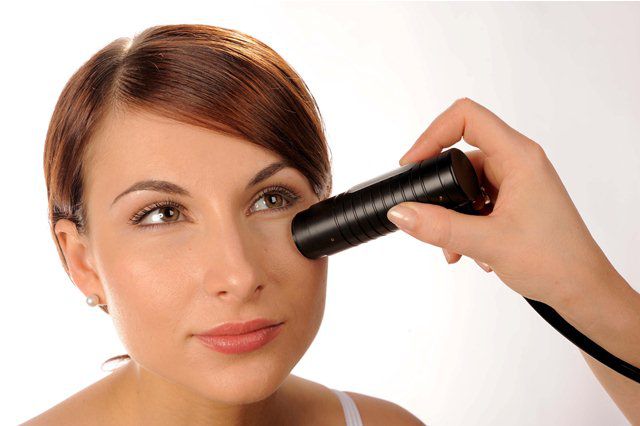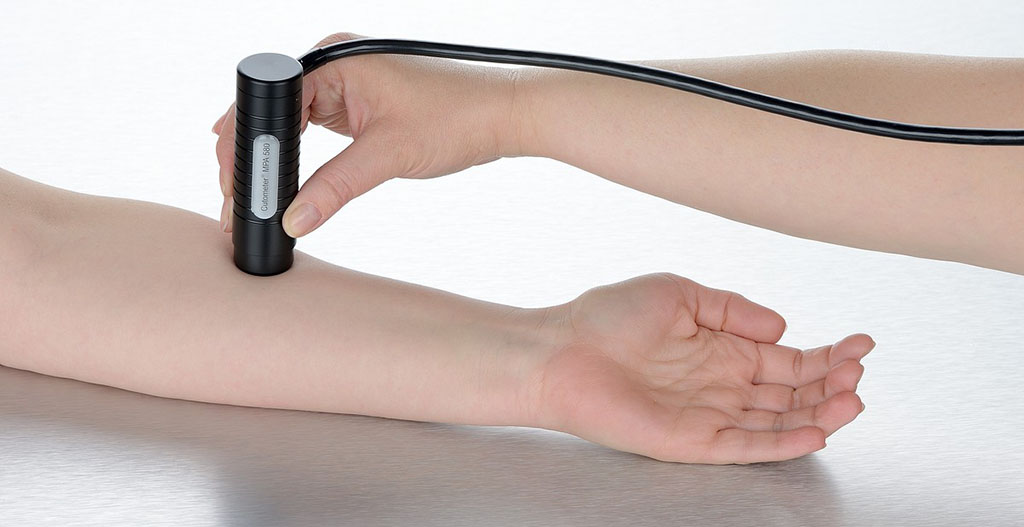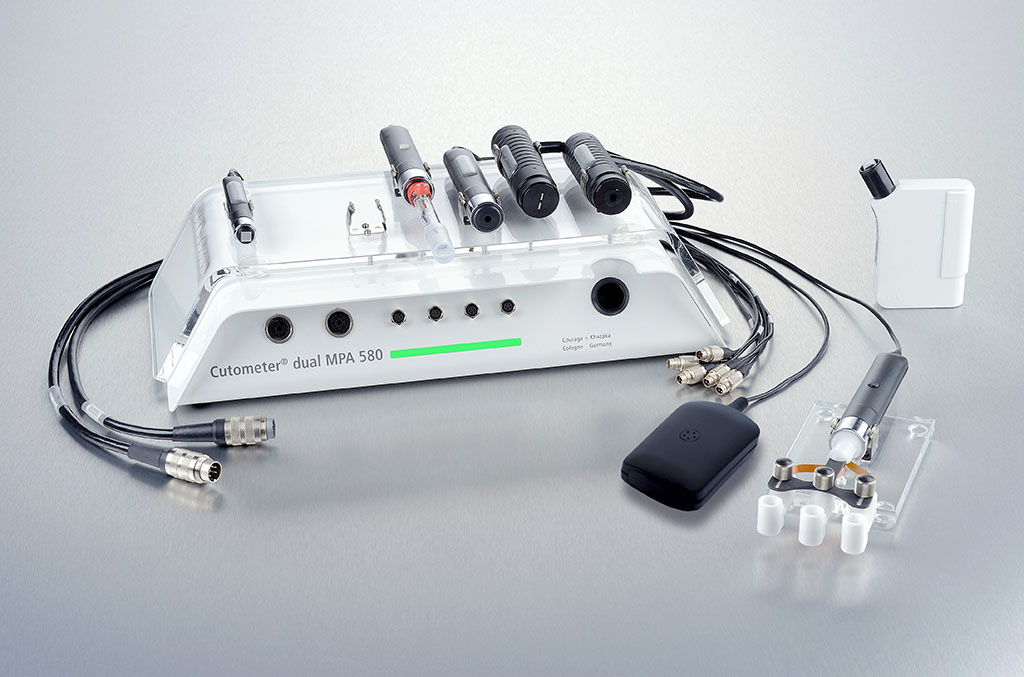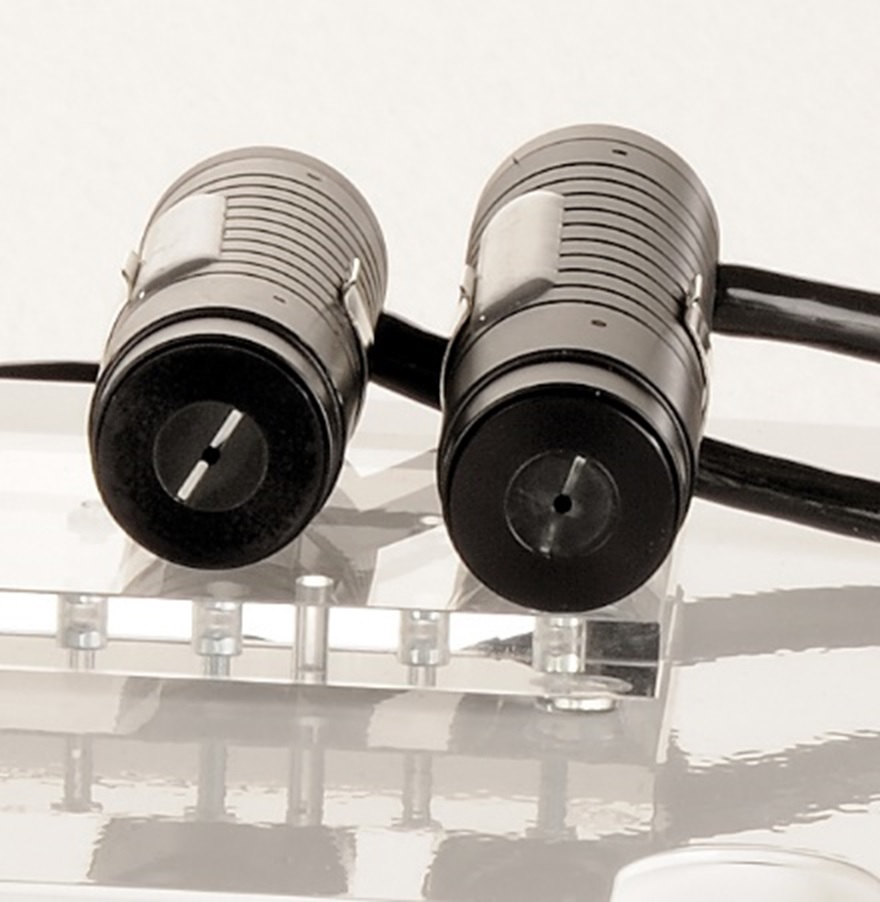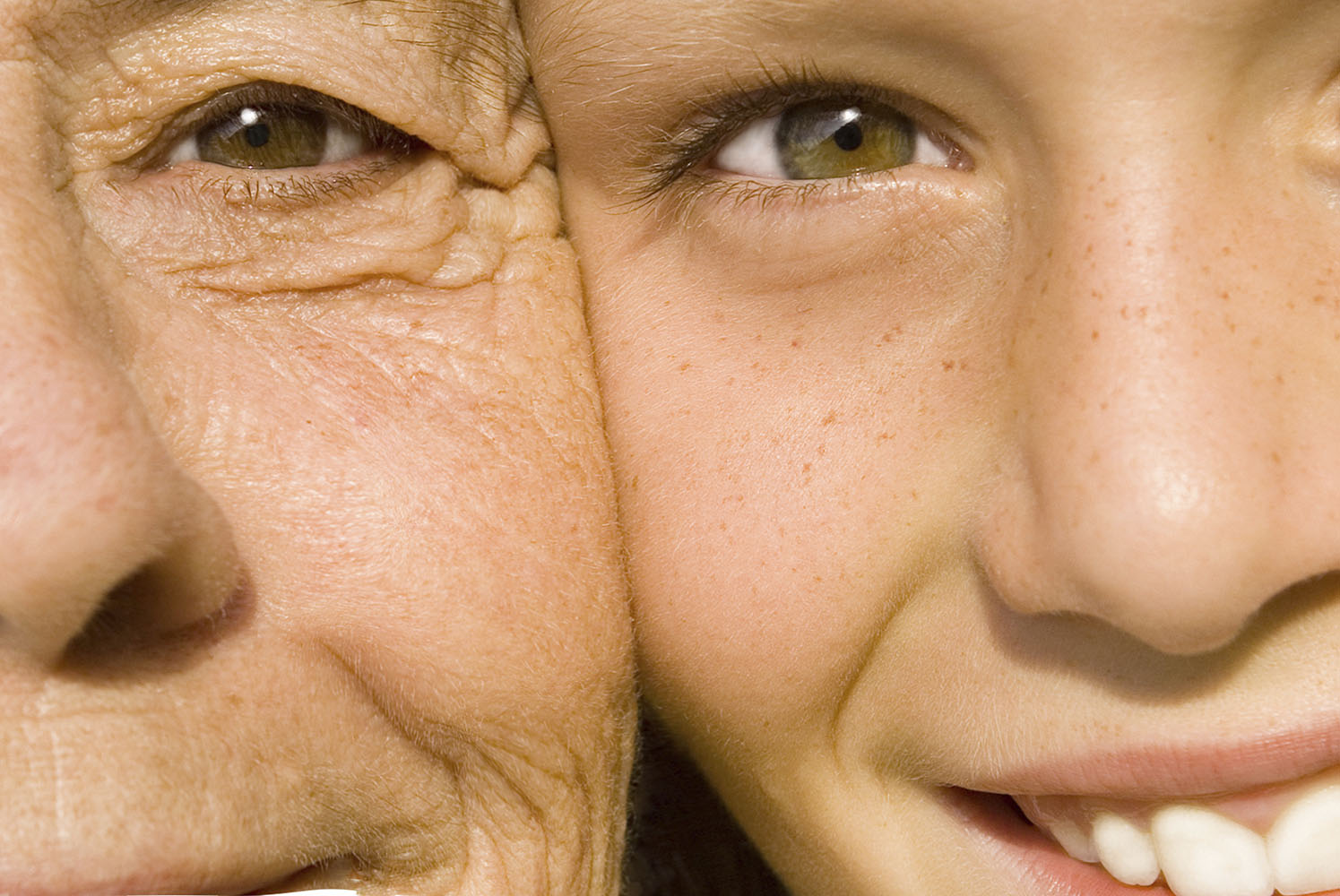Cutometer® Dual MPA 580
The World's Most Established Elasticity Measurement by Suction
For more than 35 years elasticity measurements with the Cutometer® have been recognized as standard in cosmetology and have been used to support the latest discoveries in this field. Due to its precision and ease of use compared to other elasticity measurement methods, the Cutometer® is mentioned in most studies on this subject worldwide.
Measurement Principle
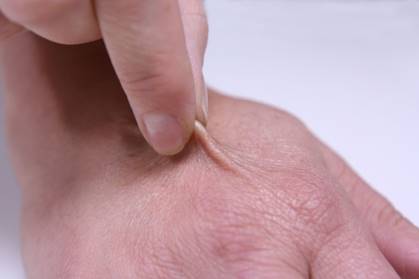
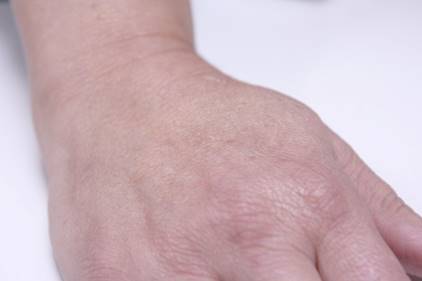 The measuring principle of the Cutometer® is based on the suction method, where negative pressure deforms the skin mechanically. The pressure is created in the device and draws the skin into the aperture of the probe and after a defined time, releases it again.
The measuring principle of the Cutometer® is based on the suction method, where negative pressure deforms the skin mechanically. The pressure is created in the device and draws the skin into the aperture of the probe and after a defined time, releases it again.
Inside the probe, the penetration depth is determined 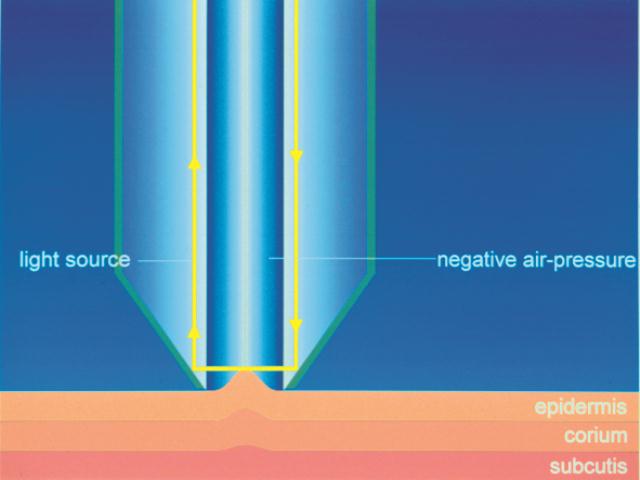 by a non-contact optical measuring system. This optical measuring system consists of a light source and a light receptor, as well as two prisms facing each other, which project the light from transmitter to receptor. The light intensity varies due to the penetration depth of the skin. The resistance of the skin to the negative pressure (firmness) and its ability to return into its original position (elasticity) are displayed as curves (penetration depth in mm/time) in real time during the measurement. From these curves a variety of interesting measurement parameters can be calculated related to elastic and visco-elastic properties of skin surface and skin aging.
by a non-contact optical measuring system. This optical measuring system consists of a light source and a light receptor, as well as two prisms facing each other, which project the light from transmitter to receptor. The light intensity varies due to the penetration depth of the skin. The resistance of the skin to the negative pressure (firmness) and its ability to return into its original position (elasticity) are displayed as curves (penetration depth in mm/time) in real time during the measurement. From these curves a variety of interesting measurement parameters can be calculated related to elastic and visco-elastic properties of skin surface and skin aging.
The typical shape of a curve of human skin is based on the different forces of elastin and collagen in the skin. Elastin is responsible for the  flexibility of the skin whereas collagen’s main task is to keep the skin in shape.
flexibility of the skin whereas collagen’s main task is to keep the skin in shape.
The first, very straight part of the curve is shaped by the proportion of elastin in the skin as it easy to displace and very flexible. When skin starts to “creep” inside the probe, the collagen has taken over. It is stronger and resists the mechanical force better. Immediately after the pressure of the device has ceased, the collagen start to bring skin back to its original shape. Therefore in young skin with fresh collagen, the skin instantly returns more closely to its original position than in aged skin. In the end, eventually the elastin sees to the complete recovery of the skin.
Advantages of the Cutometer®
- The measurement is monitored as live curves on the screen.
- The small, convenient size of the probe allows successful measurement of skin areas that are difficult to reach.
- The probe contains an elastic spring that provides constant pressure of the probe on the skin.
- The probe can be delivered with several aperture sizes (2, 4, 6 and 8 mm Ø) to fit different skin sites and different study requirements. The Cutometer® dual MPA 580 can feature two elasticity measurement probes with different aperture Ø at the same time.
- The settings in the programme are flexible and set by the user according to different applications (suction time, relaxation time, pressure/pressure rate, repetitions, etc.).
- In addition to the well-established elasticity
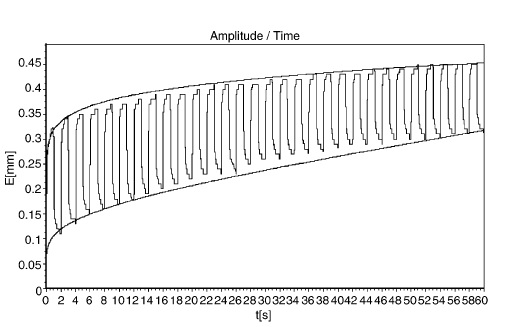 parameters known from literature, interesting area parameters can be calculated. If suction is applied to one skin site with repetition the fatigue of the skin can be determined.
parameters known from literature, interesting area parameters can be calculated. If suction is applied to one skin site with repetition the fatigue of the skin can be determined. - All data of the curves (penetration depths per milliseconds and all results) are immediately available for Excel® spreadsheets (4 curves at the same time).
- The accuracy of the Cutometer® probe can be checked anytime easily.
- The probe head can easily be cleaned after each measurement.
- Worldwide established method to look at skin's elasticity and its biological age with a broad range of studies.
- The Cutometer® MPA 580 is at the same time a Multi Probe Adapter system and can be used with the Sebumeter® and up to 4 other probes of your choice.
Measurement Parameters
The software of the Cutometer® MPA 580 allows to calculate a lot of interesting parameters from the different portions of the measurement curve. Here a short overview:
R-Parameters (extremely well documented in literature for more than 20 years)
- R0: stretchability/firmness mm (maximum amplitude of the curve)
- R1/R4: ability of the skin to return to its original state (minimum amplitude after relaxation)
- R2: visco-elasticity in % (resistance to the mechanical force versus ability of returning)
- R3/R9: Tiring effect (Fatigue) visible for repeated suction/relaxation
- R5: net elasticity: elastic portion of the suction part versus the elastic portion of the relaxation part %
- R6: Portion of the visco-elasticity of the curve in %
- R7: Portion of the elasticity compared to the complete curve in %
- R8: Complete relaxation after the pressure is cut off in mm

- F1: Area above the curve (in a rectangle from the max. amplitude). The more elastic, the less area there is
- F2: “Fatigue” + “Skin Energy”
- F3: Area within the curve (enveloped) represents the skin fatigue
- F4: area beneath the curve, represents the firmness of the skin (its resistance to the suction).
Q-Parameters:

A set of parameters developed by the scientist Di Qu (Senior Research Scientist, R&D Skin Care, Amway Corporation, Ada, Michigan, USA) has been added, showing interesting correlations between skin age and the elastic and viscous recovery of the curves:
- Q0: Maximum recovery area
- Q1: Total recovery (overall elasticity) - (QE + QR)/Q0
- Q2: Elastic recovery - QE / Q0
- Q3: Viscoelastic recovery - QR / Q0
To receive the areas QE and QR you have to spread a tangent at the graph and through the highest point = R0. The inflection point is the point, where the tangent varies from the graph. At this point the areas QE and QR are divided.
Fields of Application
The elasticity measurement with the Cutometer® is the basic measurement for all cosmetic applications.
- It is indispensable for formulation, efficacy testing and claim support for all kinds of cosmetic products.
- Typical claims (examples) substantiated with the Cutometer®: firmness enhancing, lifting, toning, anti-aging, improves skin elasticity, rejuvenating, against skin fatigue/slackness, improves cellulite/stretch marks, improves softness (e.g. callus), improves stiffness/hardness (e.g. scar tissue), and more.
- Important in dermatological basic research in humans and animals.

- Other materials like food, textiles can also be assessed.
Technical Data
Device: Dimensions: 39 x 22.5 x 7.6 cm, Weight: 3.9 kg, Power supply: external 100-240 VAC, 47-63 Hz, DC 12V/4A, Port: USB 2.0, type B connector
Probe: Dimensions: 10.7 cm x Ø 2.4 cm, Weight: 165 g incl. air tube, Measuring aperture: 2 mm Ø standard (4, 6 and 8 mm Ø on request)
Measurement principle: suction (pressure setting up to 500 mbar), Units: mm penetration depth shown as curves in real time, Measurement uncertainty: ± 3%
Computer: Windows® 10/11, USB 2.0/3.0, performance must meet system requirements (please ask for details).
Technical changes may be made without prior notice.


